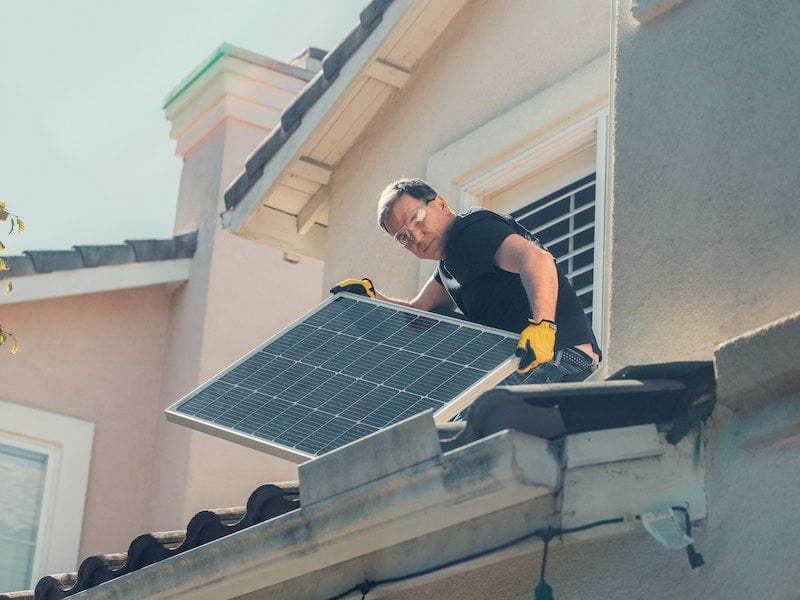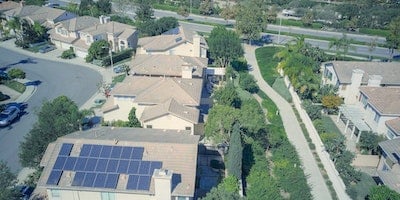
How many solar panels do I need?
Learn how many solar panels you need
Is solar right for you?
Find out in less than a minute.
How many solar panels do I need?
One of the most common questions people ask when researching solar is “How many solar panels do I need?” The correct answer will vary based on the amount of energy you want to generate, the efficiency of your solar panels, and the climate (sunlight) your home gets.
The average home in the U.S. needs 21 solar panels to effectively generate enough power to offset its energy usage. However, using batteries, your energy usage habits and other factors should be considered.
How to calculate the number of solar panels you need
There are several factors that will determine the number of solar panels you will need to meet your goals. These steps will help you walk through the process. Want to skip the headache? Our solar calculator will help you answer all these questions in just a few seconds.
Step 1: Determine your solar energy goal(s)
What is the goal of your solar system? Are you trying to eliminate your electric bill? Are you trying to have a backup power source in case of an outage? Are you trying to offset a portion of your carbon footprint?
There are many reasons people decide to invest in solar. Your goal for your system will determine how much energy you want to generate and thus how many panels you need. For example, a solar panel and battery system to serve as a backup system for a power outage will be different from someone who wants to generate enough electricity for an entire home.
Step 2: Determine the amount of energy you need to generate
After you settle on the goal of your system it’s time to calculate the number of kilowatt-hours (kWh) it needs to generate to meet your expectations.
If the system is for your existing home you can refer back to past utility bills to see the amount of power you use in an average month. You can also use our solar calculator to pull your historical energy consumption.
According to the Energy Information Administration, the average US home uses about 900 kWh of electricity per month.
900 kwh X 12 months = 10,800 kWh
This number (10,800) is the system size you will need to meet your goals.
System size = Avg. kWh / month x 12 months
If your solar array is only going to be used as a backup, it’s probably a good idea to think about how much energy you need to charge a solar battery and how much energy you need to run essential items.
Step 3: Production Ratio
Solar panel production ratio is the estimated electricity output of a system over time (kWh) to the actual wattage of the system (W). For example, a 10 kW solar system that produces 15 kWh of electricity has a production ratio of 1.5. The higher the production ratio the more efficient the solar panel.
Production ratios vary so using a range like 1.2-1.8 can help determine best and worst-case scenarios.
The production ratio is dependent on the amount of sunlight your home receives. Google offers a free service called Project Sunroof that will tell you how much sunlight your home gets in a year.
Step 4: Solar panel wattage
Different types of solar panels will produce more or less electricity with the same amount of light. Wattage is measured in watts (W) and is sometimes called power rating. Residential panels vary from 150-400 watts. Most systems use panels that are around 320 watts each.
Since most solar panels are the same size (65in X 39 inches) you may consider using higher wattage solar panels if you are short on space.
Step 5: Calculate the number of solar panels you need
To calculate the number of solar panels you need we will use the numbers from steps 2 - 4 (system size, production ratio, and wattage).
Solar panels needed = system size / production ratio / wattage
Using numbers from our example:
Solar panels needed = 10,800 kW / 1.5 / 320W
Using these numbers means we would need 22.5 solar panels. But since you can’t chop a solar panel in half we would either need 23 panels or could reduce the number of panels we need by using a higher wattage panel. For example, using a 400 W panel means we only need 18 panels.
Solar panels needed (18) = 10,800 / 1.5 / 400W
Number of solar panels for specific system sizes:
In our example, we broke down how to calculate the number of solar panels installed you need to match the average monthly electricity bill for a home. The chart below gives more examples of the number of panels needed based on a 1.5 production ratio and 320-watt panels.
| System Size | Number of Panels | Annual Production (kWh) |
|---|---|---|
| 4 kW | 8 | 6400 |
| 5 kW | 10 | 8000 |
| 6 kW | 13 | 9600 |
| 7 kW | 15 | 11200 |
| 8 kW | 17 | 12800 |
| 9 kW | 19 | 14400 |
| 10 kW | 21 | 16000 |
| 11 kW | 23 | 17600 |
| 12 kW | 25 | 19200 |
| 13 kW | 27 | 20800 |
| 14 kW | 29 | 22400 |
| 15 kW | 31 | 24000 |
| 16 kW | 33 | 25600 |
How much space do you need for solar panels?
Solar panels aren’t exactly small. Most residential solar panels are 65in x 39in or 17.6 square feet. If your roof space is limited by size or amount of sunlight it can be difficult to install the number of panels you need to match your energy needs.
This chart shows the amount of square footage you need for different sized systems:
| System size | Number of panels needed | Sq Ft |
|---|---|---|
| 4 | 8 | 147 |
| 5 | 10 | 183 |
| 6 | 13 | 220 |
| 7 | 15 | 257 |
| 8 | 17 | 293 |
| 9 | 19 | 330 |
| 10 | 21 | 367 |
| 11 | 23 | 403 |
| 12 | 25 | 440 |
| 13 | 27 | 477 |
| 14 | 29 | 513 |
| 15 | 31 | 550 |
| 16 | 33 | 587 |
How much do solar panels weigh?
Most solar panels weigh about 40 pounds. But, that is just the solar panel itself. By the time you include various bracketry and components that weight starts to stack up. Your solar installer will help determine if your roof can support installation and in some cases, additional support may need to be added.
Written by Thad Warren
Thad is a native Texan who has worked in the energy industry for just over 5 years.
Connect
Recent Posts
Compare Texas Solar Buyback Plans
Discover the best Texas solar energy buy back programs for 2025! Compare rates, terms, and providers to maximize savings and make the most of your solar investment.
September 2025

7 minutes

How Efficient Are Solar Panels
How efficient are solar panels compared to other types of energy generation?
March 2023

4 minutes

What You Need To Know About The California Solar Mandate
Learn how the California Solar Mandate changes how new homes are built.
July 2023

4 minutes



